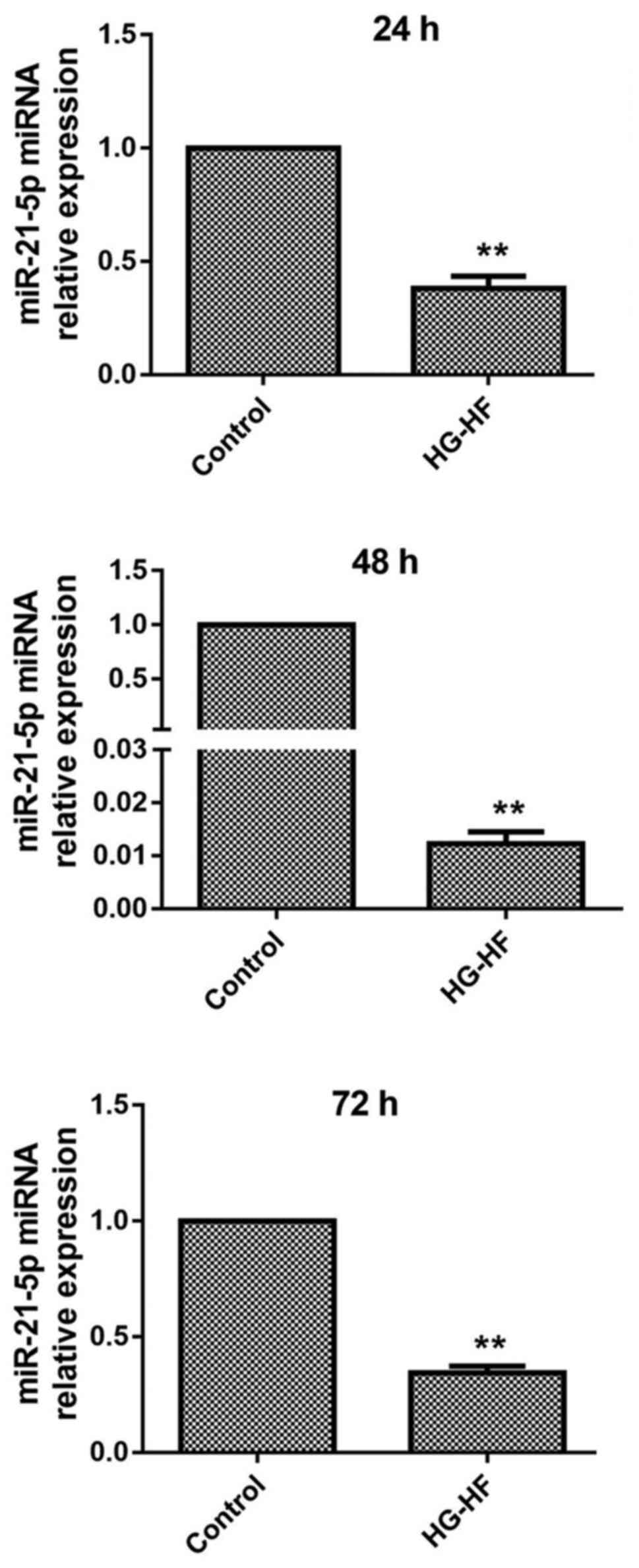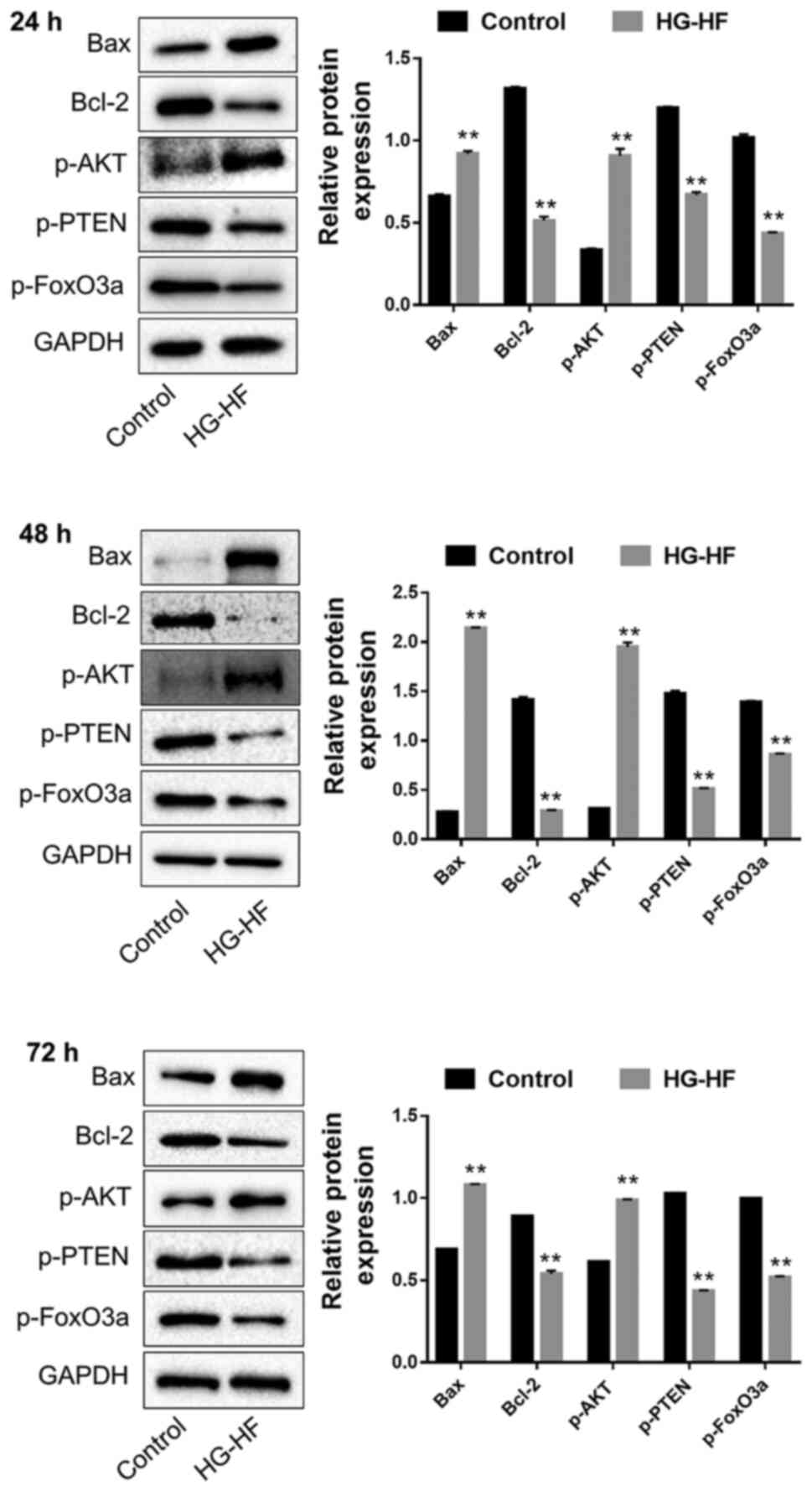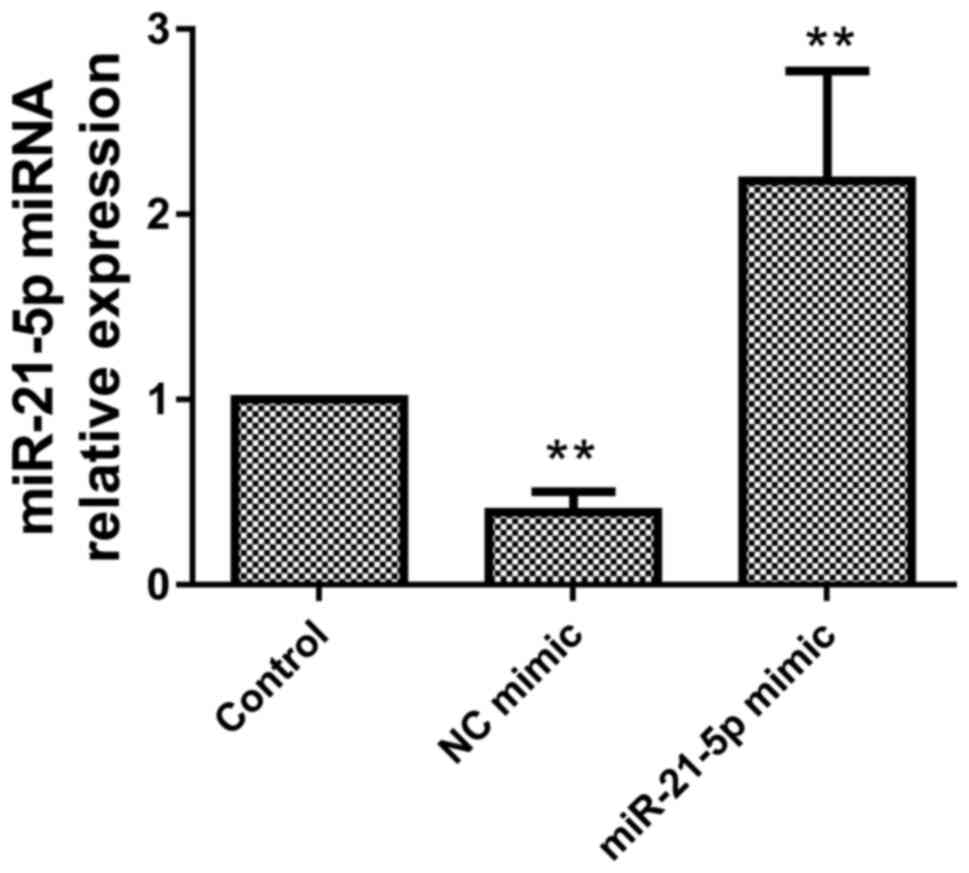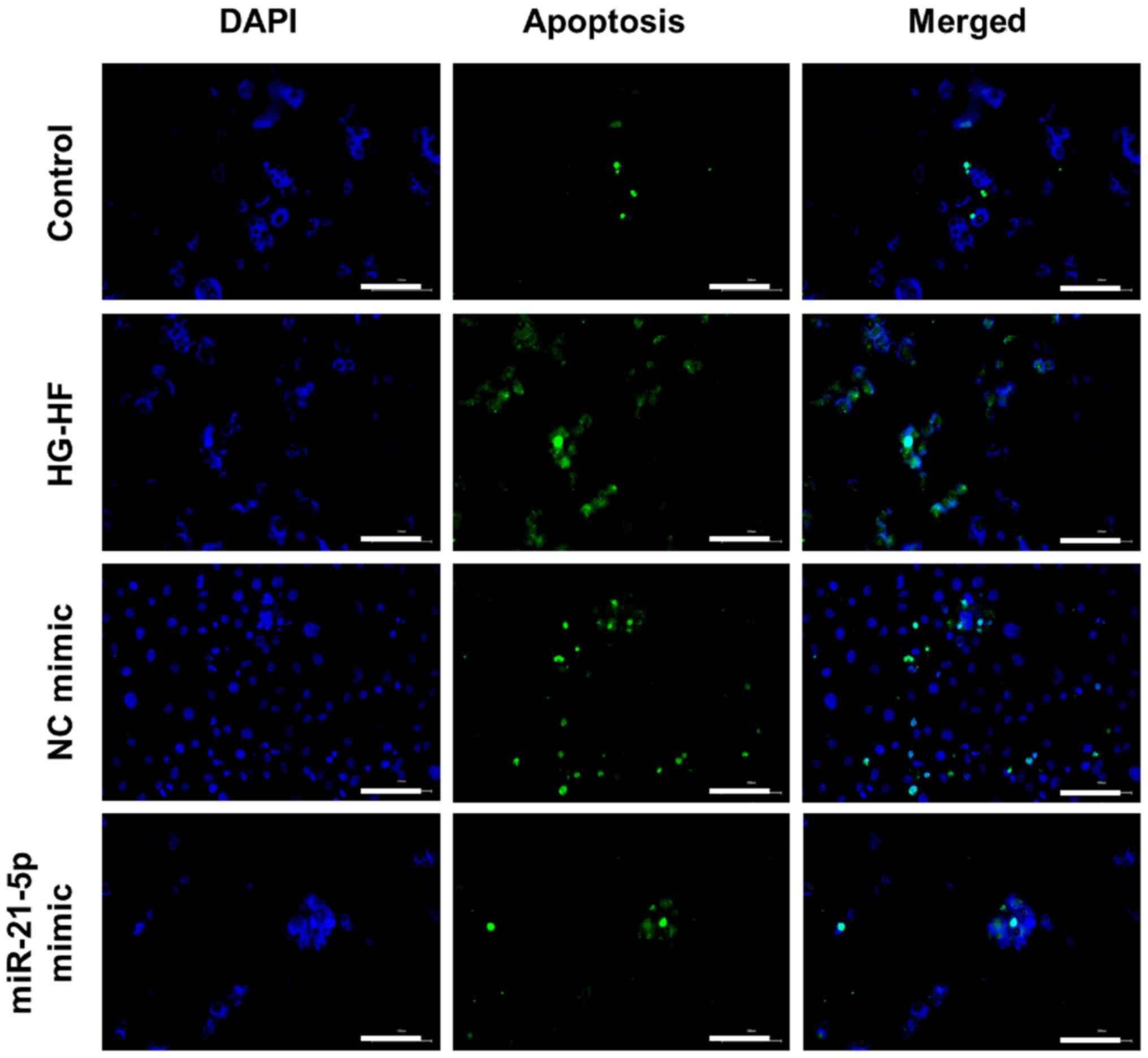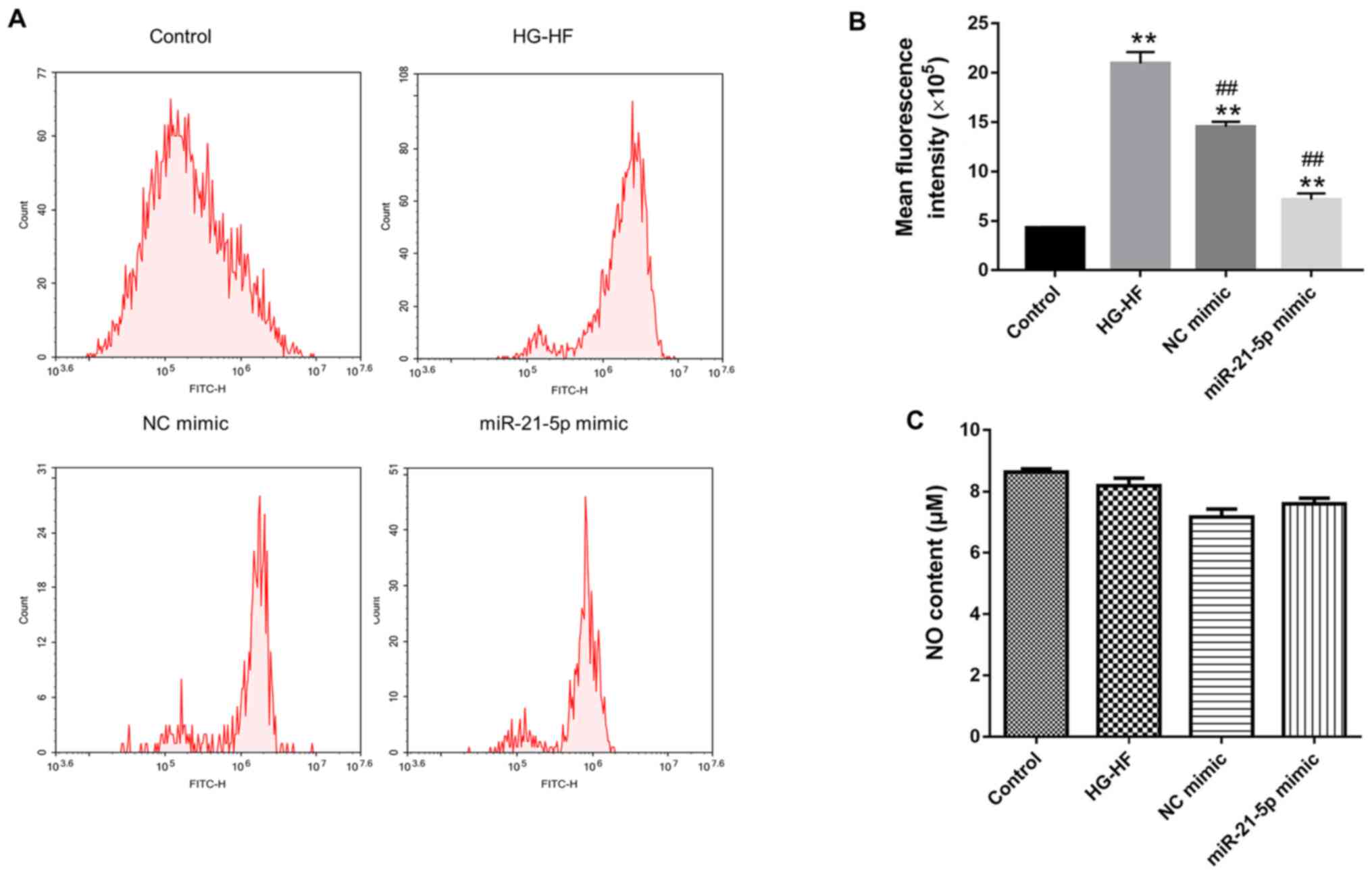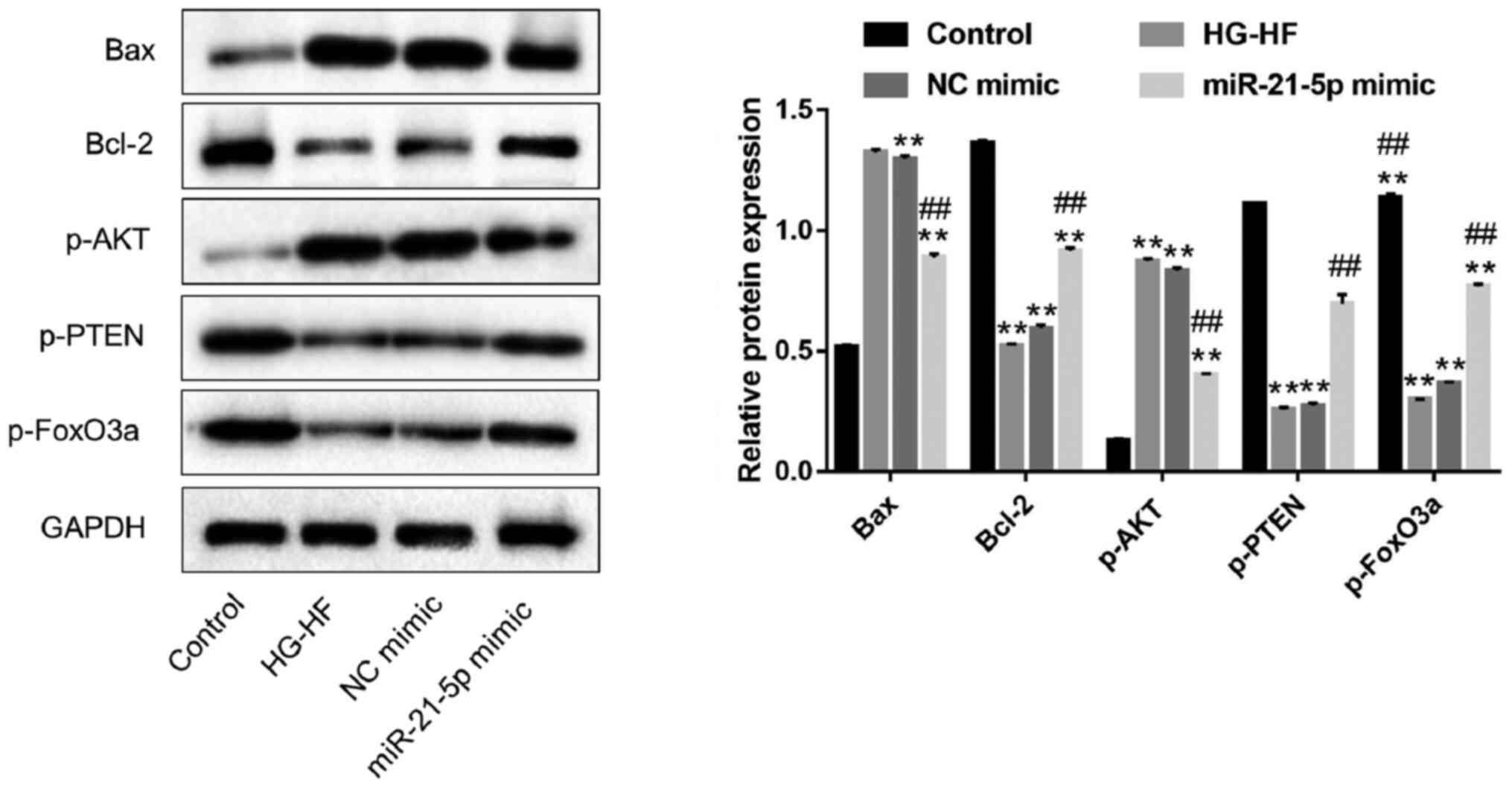|
1
|
Picano E: Diabetic cardiomyopathy the
importance of being earliest. J Am Coll Cardi-ol. 42:454–457.
2003.PubMed/NCBI View Article : Google Scholar
|
|
2
|
Avogaro A, Vigili de Kreutzenberg S, Negut
C, Tiengo A and Scognamiglio R: Diabetic cardiomyopathy: A
metabolic perspective. Am J Cardiol. 93:13A–16A. 2004.PubMed/NCBI View Article : Google Scholar
|
|
3
|
Zhang BB, Zhou G and Li C: AMPK: An
emerging drug target for diabetes and the metabolic syndrome. Cell
Metab. 9:407–416. 2009.PubMed/NCBI View Article : Google Scholar
|
|
4
|
Li B, Zheng Z, Wei Y, Wang M, Peng J, Kang
T, Huang X, Xiao J, Li Y and Li Z: Therapeutic effects of
neuregulin-1 in diabetic cardiomyopathy rats. Cardiovasc Diabetol.
10(69)2011.PubMed/NCBI View Article : Google Scholar
|
|
5
|
Wang Y, Zou L, Wu T, Xiong L, Zhang T,
Kong L, Xue Y and Tang M: Identification of mRNA-miRNA crosstalk in
human endothelial cells after exposure of PM2.5 through integrative
transcriptome analysis. Ecotoxicol Environ Saf. 169:863–873.
2019.PubMed/NCBI View Article : Google Scholar
|
|
6
|
Yang J, Shi G, Gong Y, Cai J, Zheng Y and
Zhang Z: LncRNA 0003250 accelerates heart autophagy and binds to
miR-17-5p as a competitive endogenous RNA in chicken induced by
selenium deficiency. J Cell Physiol. 236:157–177. 2021.PubMed/NCBI View Article : Google Scholar
|
|
7
|
Yang J, Gong Y, Cai J, Liu Q and Zhang Z:
lnc-3215 Suppression Leads to Calcium Overload in Selenium
Deficiency-Induced Chicken Heart Lesion via the
lnc-3215-miR-1594-TNN2 Pathway. Mol Ther Nucleic Acids. 18:1–15.
2019.PubMed/NCBI View Article : Google Scholar
|
|
8
|
Song M, Zhao G, Sun H, Yao S, Zhou Z,
Jiang P, Wu Q, Zhu H, Wang H, Dai C, et al: circPTPN12/miR-21-5
p/Np63alpha pathway contributes to human endometrial fibrosis.
eLife 10: e65735.
|
|
9
|
Liu E, Lv L, Zhan Y, Ma Y, Feng J, He Y,
Wen Y, Zhang Y, Pu Q, Ji F, et al: METTL3/N6-methyladenosine/
miR-21-5p promotes obstructive renal fibrosis by regulating
inflammation through SPRY1/ERK/NF-κB pathway activation. J Cell Mol
Med. 25:7660–7674. 2021.PubMed/NCBI View Article : Google Scholar
|
|
10
|
Qiao L, Hu S, Liu S, Zhang H, Ma H, Huang
K, Li Z, Su T, Vandergriff A, Tang J, et al: microRNA-21-5p
dysregulation in exosomes derived from heart failure patients
impairs regenerative potential. J Clin Invest. 129:2237–2250.
2019.PubMed/NCBI View Article : Google Scholar
|
|
11
|
Raupach A, Torregroza C, Niestegge J,
Feige K, Klemm-Meyer S, Bauer I, Brandenburger T, Grievink H,
Heinen A and Huhn R: MiR-21-5p but not miR-1-3p expression is
modulated by preconditioning in a rat model of myocardial
infarction. Mol Biol Rep. 47:6669–6677. 2020.PubMed/NCBI View Article : Google Scholar
|
|
12
|
Dai B, Li H, Fan J, Zhao Y, Yin Z, Nie X,
Wang DW and Chen C: MiR-21 protected against diabetic
cardiomyopathy induced diastolic dysfunction by targeting gelsolin.
Cardiovasc Diabetol. 17(123)2018.PubMed/NCBI View Article : Google Scholar
|
|
13
|
Balcells I, Cirera S and Busk PK: Specific
and sensitive quantitative RT-PCR of miRNAs with DNA primers. BMC
Biotechnol. 11(70)2011.PubMed/NCBI View Article : Google Scholar
|
|
14
|
Livak KJ and Schmittgen TD: Analysis of
relative gene expression data using real-time quantitative PCR and
the 2(-Delta Delta C(T)) Method. Methods. 25:402–408.
2001.PubMed/NCBI View Article : Google Scholar
|
|
15
|
Xia Y, Gong L, Liu H, Luo B, Li B, Li R,
Li B, Lv M, Pan J and An F: Inhibition of prolyl hydroxylase 3
ameliorates cardiac dysfunction in diabetic cardiomyopathy. Mol
Cell Endocrinol. 403:21–29. 2015.PubMed/NCBI View Article : Google Scholar
|
|
16
|
Wang CC and Reusch JE: Diabetes and
cardiovascular disease: Changing the focus from glycemic control to
improving long-term survival. Am J Cardiol. 110 (Suppl 9):58B–68B.
2012.PubMed/NCBI View Article : Google Scholar
|
|
17
|
Lee Y and Gustafsson AB: Role of apoptosis
in cardiovascular disease. Apoptosis. 14:536–548. 2009.PubMed/NCBI View Article : Google Scholar
|
|
18
|
Shekhar A, Heeger P, Reutelingsperger C,
Arbustini E, Narula N, Hofstra L, Bax JJ and Narula J: Targeted
Imaging for Cell Death in Cardiovascular Disorders. JACC Cardiovasc
Imaging. 11:476–493. 2018.PubMed/NCBI View Article : Google Scholar
|
|
19
|
Song Z, Shen F, Zhang Z, Wu S and Zhu G:
Calpain inhibition ameliorates depression-like behaviors by
reducing inflammation and promoting synaptic protein expression in
the hippocampus. Neuropharmacology. 174(108175)2020.PubMed/NCBI View Article : Google Scholar
|
|
20
|
Song Z, Chen H, Xu W, Wu S and Zhu G:
Basolateral amygdala calpain is required for extinction of
contextual fear-memory. Neurobiol Learn Mem. 155:180–188.
2018.PubMed/NCBI View Article : Google Scholar
|
|
21
|
Myers MP, Stolarov JP, Eng C, Li J, Wang
SI, Wigler MH, Parsons R and Tonks NK: P-TEN, the tumor suppressor
from human chromosome 10q23, is a dual-specificity phosphatase.
Proc Natl Acad Sci USA. 94:9052–9057. 1997.PubMed/NCBI View Article : Google Scholar
|
|
22
|
Shi YH, Wang YX, You JF, Heng WJ, Zhong HH
and Fang WG: Activation of HIF-1 by bFGF in breast cancer: Role of
PI-3K and MEK1/ERK pathways. Zhonghua Yi Xue Za Zhi. 84:1899–1903.
2004.PubMed/NCBI(In Chinese).
|
|
23
|
Song ZJ, Yang SJ, Han L, Wang B and Zhu G:
Postnatal calpeptin treatment causes hippocampal neurodevelopmental
defects in neonatal rats. Neural Regen Res. 14:834–840.
2019.PubMed/NCBI View Article : Google Scholar
|
|
24
|
Li D, Qu Y, Mao M, Zhang X, Li J, Ferriero
D and Mu D: Involvement of the PTEN-AKT-FOXO3a pathway in neuronal
apoptosis in developing rat brain after hypoxia-ischemia. J Cereb
Blood Flow Metab. 29:1903–1913. 2009.PubMed/NCBI View Article : Google Scholar
|
|
25
|
Landgraf P, Rusu M, Sheridan R, Sewer A,
Iovino N, Aravin A, Pfeffer S, Rice A, Kamphorst AO, Landthaler M,
et al: A mammalian microRNA expression atlas based on small RNA
library sequencing. Cell. 129:1401–1414. 2007.PubMed/NCBI View Article : Google Scholar
|
|
26
|
Sayed D, He M, Hong C, Gao S, Rane S, Yang
Z and Abdellatif M: MicroRNA-21 is a downstream effector of AKT
that mediates its antiapoptotic effects via suppression of Fas
ligand. J Biol Chem. 285:20281–20290. 2010.PubMed/NCBI View Article : Google Scholar
|
|
27
|
Cheng Y, Liu X, Zhang S, Lin Y, Yang J and
Zhang C: MicroRNA-21 protects against the H(2)O(2)-induced injury
on cardiac myocytes via its target gene PDCD4. J Mol Cell Cardiol.
47:5–14. 2009.PubMed/NCBI View Article : Google Scholar
|
|
28
|
He Z, Long J, Yang C, Gong B, Cheng M,
Wang Q and Tang J: LncRNA DGCR5 plays a tumor-suppressive role in
glioma via the miR-21/Smad7 and miR-23a/PTEN axes. Aging (Albany
NY). 12:20285–20307. 2020.PubMed/NCBI View Article : Google Scholar
|
|
29
|
Wang J, Yue J, Xia Q, Jiao X and Zhi J:
Angiotensin II type i receptor agonistic autoantibodies induces
apoptosis of cardiomyocytes by downregulating miR21 in
preeclampsia: A mechanism study. Am J Transl Res. 11:2339–2349.
2019.PubMed/NCBI
|
|
30
|
Roy S, Khanna S, Hussain SR, Biswas S,
Azad A, Rink C, Gnyawali S, Shilo S, Nuovo GJ and Sen CK: MicroRNA
expression in response to murine myocardial infarction: miR-21
regulates fibroblast metalloprotease-2 via phosphatase and tensin
homologue. Cardiovasc Res. 82:21–29. 2009.PubMed/NCBI View Article : Google Scholar
|
|
31
|
Meng F, Henson R, Wehbe-Janek H, Ghoshal
K, Jacob ST and Patel T: MicroRNA-21 regulates expression of the
PTEN tumor suppressor gene in human hepatocellular cancer.
Gastroenterology. 133:647–658. 2007.PubMed/NCBI View Article : Google Scholar
|
|
32
|
Shen F, Song Z, Xie P, Li L, Wang B, Peng
D and Zhu G: Polygonatum sibiricum polysaccharide prevents
depression-like behaviors by reducing oxidative stress,
inflammation, and cellular and synaptic damage. J Ethnopharmacol.
275(114164)2021.PubMed/NCBI View Article : Google Scholar
|
|
33
|
Qian M, Tan HM, Yu N, Wang T and Zhang Q:
Inactivated Sendai Virus Induces ROS-dependent Apoptosis and
Autophagy in Human Prostate Cancer Cells. Biomed Environ Sci.
31:280–289. 2018.PubMed/NCBI View Article : Google Scholar
|
|
34
|
Yang H, Xie Y, Yang D and Ren D: Oxidative
stress-induced apoptosis in granulosa cells involves JNK, p53 and
Puma. Oncotarget. 8:25310–25322. 2017.PubMed/NCBI View Article : Google Scholar
|
|
35
|
Sears CE, Ashley EA and Casadei B: Nitric
oxide control of cardiac function: Is neuronal nitric oxide
synthase a key component? Philos Trans R Soc Lond B Biol Sci.
359:1021–1044. 2004.PubMed/NCBI View Article : Google Scholar
|















